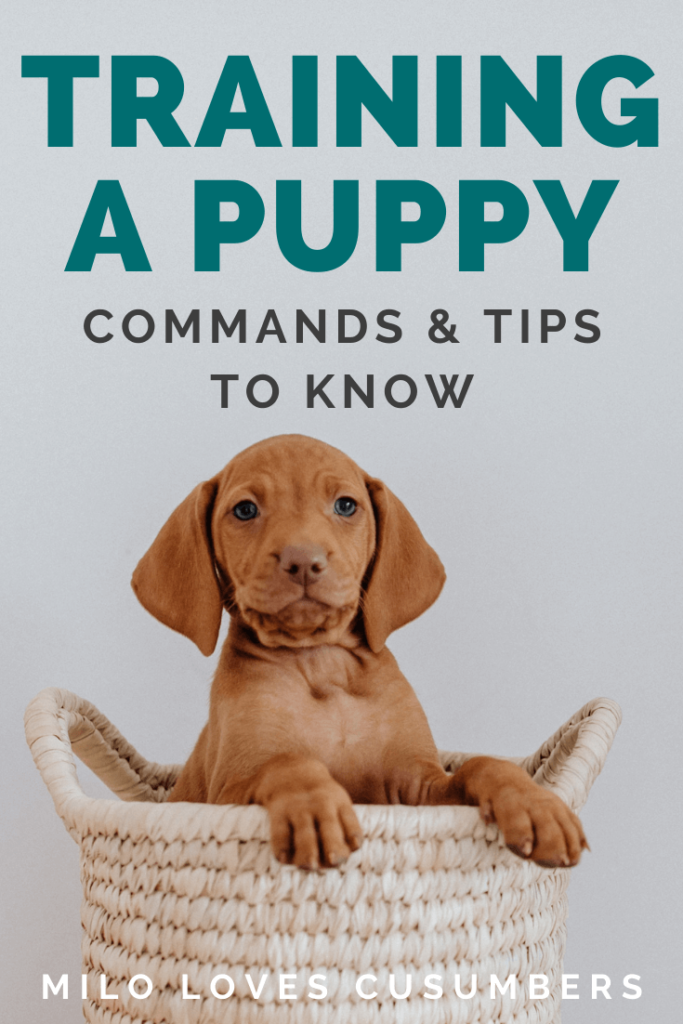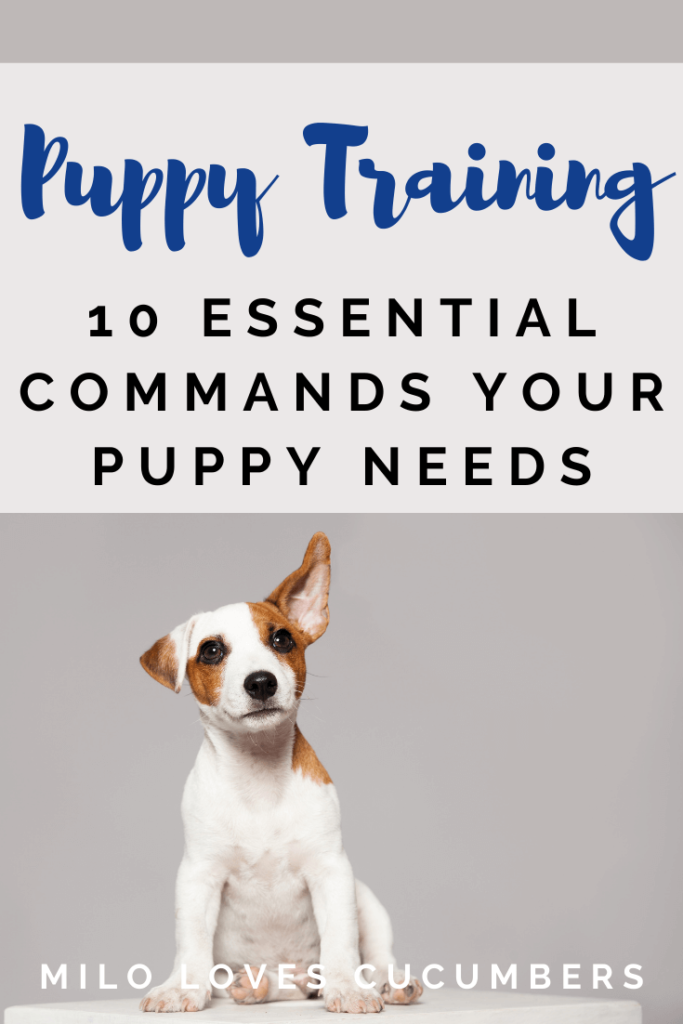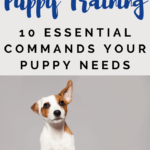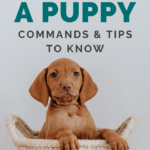Getting a new puppy is one of the most exciting parts of dog ownership. The day I brought Milo home was one of the most exciting days I can remember. But of course, having a new puppy is not without its challenges. That’s why teaching your new puppy these essential puppy commands is so important – to prevent them from getting into trouble and so that you can keep them safe at all times!
Here are 10 essential puppy commands to teach your new fur baby:
- No
- Sit
- Stay
- Drop it
- Leave it
- Paw
- Come
- Heel
- Off
- Go potty
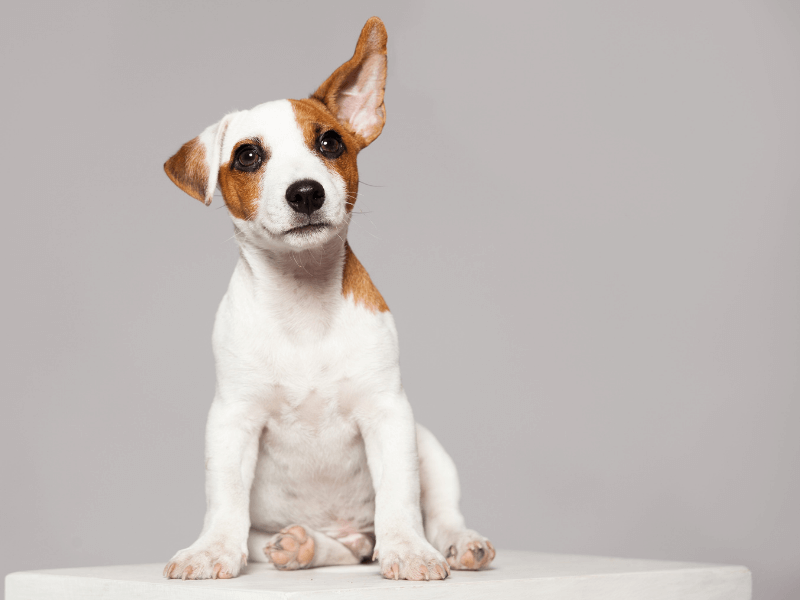
Disclosure: This post may contain affiliate links. If you purchase a product through one of our affiliate links we make a small commission from the sale at no extra cost to our readers.
1 – No
“No” is probably the first command that Milo learned, mostly by default.
And for good reason.
Puppies are notoriously getting into trouble and understanding the “no” command can be a universal way to teach your fur baby that what they are doing is unacceptable.
Whether that’s pulling at the tv cables or going potty on the rug.
No comes in handy quite a bit when your pup still doesn’t understand other commands and can keep your puppy away from potentially dangerous situations.
Whenever you spot your fur baby doing something mischievous you can make use of this command.
As your puppy learns other more specific commands, “no” will become less important. But teaching them no is a stepping stone for them to understand other, more complex instructions.
2 – sit
Sit is one of my favorite puppy commands and comes in handy every day.
It trains your pup to remain well-mannered when guests are over, makes it easier to get their leash on, and makes so many other daily tasks less of a struggle.
For example – have you ever tried to put a collar/leash on a puppy while they’re bouncing around?
From the beginning, I always make Milo sit before I put his leash on – it makes it so much easier and he learns to be patient.
The same applies for meal times.
He knows that in order to get his food, he must sit and wait. That allows me to pour his food without him sticking his nose in the pantry.
And training your puppy to sit is very easy. All you need to do is have them in front of you with a treat in your hand.
Place the other hand on their bottom and push down gently while saying sit – until they sit.
Then reward them with the treat and praise.
Rinse and repeat for as many times as it takes to learn the command. But once they get the hang of it, don’t keep saying the command until they do it.
Say it once, and wait. Once they realize what you’re waiting for they will sit to get what they want.
3 – Stay
Stay is essential to keeping your puppy safe – you want them to be able to sit and stay when you need them to, so naturally stay comes right after sit.
Milo for example, will run out the door at any chance he gets. He eventually comes back – after a long (and frustrating) game of na-na-na-na-na-na-you-can’t-catch-me.
So when I open the front door to leave the house, answer the door for guests, or get a package that was delivered, telling Milo to “stay” works wonders.
This one does take some getting used to though – both for puppies and for their owners.
You must be consistent with practicing stay with your pup, if not they don’t learn how important it is.
And the last thing you want is to chase your puppy down the street!
To teach them to stay, start with the sit command.
Move on step away from them and as you step back use the command “stay.”
If they get up, start over.
After a few seconds go back to your pooch and reward him with a yummy treat!
And once he has accepted the one-step distance it is time to increase the number of steps away from him each time.
Just don’t forget to reward them and take it slow!
This command requires lots of self control for you pup, but it’s an important command to keep them safe!
4 – Drop it
Oh, drop it.
This command plays on repeat like a broken record in my house.
The kids stuffed animals? Drop it!
Whole eggs that belong on the countertop? Drop it!
Dirty socks that for some reason appeals to dogs? Drop it!
The command “drop it” is very important as it teaches your dog to drop things that can hurt them or destroy your household valuables.
This command needs to be taught to puppies instantly as pups are very curious about their surroundings and are constantly putting things in their mouths that can cause them harm.
To teach this command grab one of their favorite dog toys and let them play with it.
Then offer them a treat.
Your dog should naturally drop the toy to reach for the treat.
When they do this, say “drop it” and reward them with the treat.
As they start to understand, remove the treat altogether until they drop the toy.
Once they follow the command, praise with treats!
5- leave it
Like the drop it command, “leave it” comes in handy to keep your pup safe and avoid potentially disastrous situations.
In this scenario, your puppy hasn’t grabbed the object in question yet, but you can see that they are going to.
For example, you are out on a walk with your pup and you see a frog.
Dogs are curious of other animals by nature but eating a frog might be poisonous to your dog, so getting them to leave it alone is essential.
Another example of this is when I’m cooking dinner.
Milo is big enough to reach the countertops without having to stand up, so whenever I turn my back is an opportunity for him to grab the food – and he never missed the chance to take that opportunity!
Telling him to leave it when I see him looking at whatever is on the cutting board has become the routine in my house, and it’s saved us from having to order pizza on many, many occasions.
6 – paw
When I first got Milo, I didn’t realize how important this command would be.
Teaching your dog to give his paw is a cute way to show off to house guests. But it also comes in very handy when you need to clean your pup’s paws or check for wounds on the paw.
Whenever we come back from a particularly muddy walk I clean Milo’s paws. This is much easier when he willingly gives his paws.
Have you ever tried to grab a dog’s paws while they try to yank it away? Cleaning their paws is much more difficult!
And there have been several situations when I see a tear on Milo’s paw pad from playing outside.
Even though he doesn’t want me to get near the injury, he knows the paw command and gives me his paw to look at.
To teach your dog this command, have them sit in front of you and grab one of their front paws with your hand.
Then say “paw” and reward them.
Do this several times until they understand what you’re asking them to do. They will eventually start giving you their paw on their own in order to get the treat.
Heck, whenever I’m in the kitchen, Milo will sit next to me and voluntarily give me his paws!
When I don’t reward him for it, he gives me the other one!
Plus, teaching them to give you “the other paw” comes in handy also!
7 – come
Come is an extremely important command that your dog should be taught in the early stage of training.
This command ensures that your puppy listens to you and you have control in an emergency situation.
This essential command has saved Milo from dog fights that break out at the park, cars on the street when he gets loose, and prevents him from chasing neighborhood cats on a regular basis.
Now, even if they reluctantly come to you – come is still super important when it comes to keeping them safe!
So if you’re planning on letting your dog off leash, teaching them to “come” should be at the top of your list!
To teach this command all you need to do is put a leash on your pup and pull the leash gently while saying “come.” Do this repeatedly until he comes to you and always remember to reward your pup with a treat to motivate them to follow the command.
Especially in emergency situations, it’s essential that your dog knows they will be rewarded when they return to your side.
8 – Heel
Heel is an essential command to teach your puppy as part of good leash etiquette.
Your pup must know how to walk on a leash without pulling you in different directions.
And this habit should be developed in the early stages. As your puppy grows it will be harder to get them used to walking on a leash without pulling.
And if you have a larger breed dog like Milo, this can be problematic.
Believe me, I can’t tell you how many times I got whiplash whenever Milo would see a squirrel running past us.
Unfortunately I didn’t teach him this command as a puppy. He ended up learning this one later on – around a year old. About 3 months after I decided I didn’t want to be dragged through the parking lot anymore.
So do yourself a favor and teach this command early on!
And the bigger your new puppy gets, the more you will be glad you did!
9 – off
A 3 month old puppy jumping on people as they walk through the door…super cute.
A 110 pound dog jumping on people…not so much.
And if your pup jumps on everyone who comes to visit, there will inevitably be someone who doesn’t quite enjoy this.
This command also applies to any situation where your dog jumps. On the furniture, on the bed, or using the countertops as an elbow rest in Milo’s case.
And the bigger the dog, the harder it will be to break them out of this habit as time goes by, trust me.
Once they realize that they are too big to control, chaos is sure to follow.
So make sure you are consistent with using the “off” command!
10 – Go Potty
Anyone who has ever tried to potty train a new puppy knows that it can be quite a headache.
So teaching your new pup when and where to “go potty” is essential!
And this is definitely one command that will take some time – don’t expect them to pick it up right away. But as your pooch learns to control their potty time activities, teaching them this command will help them understand what times and places are acceptable!
Start teaching your pup this potty time command right away to save yourself the headache – even if they don’t get it for a while.
And while they might understand what you want from them, your new puppy just might not able able to hold it that long or have full control yet, so patience is key!
To teach your pup this command simply wait for them to go to the bathroom in an appropriate area – then repeat the command as they are going and reward them with treats.
Eventually they will start to associate this command with acceptable bathroom spots!
Puppy Training Tips
Here are a few tips to keep in mind while teaching your new pup these essential commands:
- Before you take your dog out of the house practice all your training with your pup in your home or backyard
- Keep training sessions short and slowly increase the duration so your puppy doesn’t get overwhelmed
- Mix physical and verbal instructions to make it easy for your fur baby to understand your commands
- Always reward your pup with praise and treats for their correct behaviors
- Be consistent and clear while teaching them the commands
- Be patient and take your time, never get frustrated or express anger towards your pup
- Only give one command at a time so your pup doesn’t get confused
- Never train with too many distractions around – if it’s too noisy, smelly or crowded your dog will lose focus quickly
- Always end your sessions on a high note – provide treats and praise so they are excited for the next training session!
Training with treats
Rewarding your pup with treats is a great way to not only keep their attention, but help them learn faster. Especially if your pup is highly motivated by food like Milo is!
Milo ended up learning most of these commands super fast since there’s very little he won’t do for a treat!
But if your fur-baby just isn’t as interested in treats you can reward them with verbal and physical praise as well!
Eventually though, I stopped giving Milo treats for every command he followed.
And there are a few reasons for that.
One, he would only listen to me when there were treats involved. The rest of the time it was like talking to a brick wall.
Two, I keep Milo on a pretty strict diet – mostly organic dog food but I’ve started incorporating in some raw diet elements also.
The more treats he gets – even when they’re mostly healthy – the further he strays from this diet.
And lastly, he started thinking that he would be getting a treat for every command he followed. He would even sit next to me and voluntarily do tricks in order to get treats!
So in my opinion – and after following the advice of Milo’s trainer, I started limiting the treats and providing more verbal praise.
Puppy Training Classes
Puppy training is easier said than done!
Some breeds are more motivated by treats than other breeds, some puppies have less of an attention span than others, and some owners lose patience quicker than others.
Thankfully, there are several options for puppy training classes that you can enroll in!
Not only will those classes help your pup to learn new commands and socialize with other dogs, but they are also a great way to spend some quality time bonding with your pup!
Plus sometimes when puppies see other dogs modeling behaviors, they copy and learn new commands!
There are many different levels of training classes – from beginner to off-leash, advanced, and protection training.
I ended up doing the basic and advanced command training with Milo at home, but ended up enrolling him in off leash and protection training classes with a one-on-one trainer.
Those classes really helped to narrow down problem behaviors and specific ways that I was enabling those behaviors!
So if your pup just doesn’t seem to be picking up proper puppy etiquette at home, it might be time to enlist some help from the professionals!
The only way to guarantee success in teaching your puppy these essential commands is through consistency. Your aim should be to practice these essential commands with them several times per day in short increments. As your puppy grows, you can reduce the frequency of treats and provide only verbal and physical praise!
Pin it for later!
